Combined In Situ Chemical and Sr Isotopic Compositions and U–Pb Ages of the Mushgai Khudag Alkaline Complex: Implications of Immiscibility, Fractionation, and Alteration
Abstract
1. Introduction
2. Geological Background
3. Analytical Methods
3.1. Petrographic Analysis
3.2. Chemical Analysis
3.3. In Situ U–Pb Dating of Apatite
3.4. In Situ Sr Isotope Determinations
4. Petrography
4.1. Magnetite-Apatite-Enriched Rocks and the Dominant Apatite
4.2. Syenite and Apatite
4.3. Carbonatite and the Dominant Calcite
5. Results
5.1. Major and Trace Element Compositions for Magnetite-Apatite-Enriched Rocks, Syenites, and Carbonatites
5.2. Mineral Compositions for Apatite within Magnetite-Apatite-Enriched Rocks and Syenites
5.3. Mineral Compositions for Dominant Calcite in Carbonatite
5.4. U–Pb Ages of Apatite within the Magnetite-Apatite-Enriched Rocks
5.5. In Situ Sr Isotopic Compositions
6. Discussion
6.1. Age and Sources of the Mushgai Khudag Complex
6.2. Fractional Crystallization and Hydrothermal Alteration Recorded in Apatite
6.3. REE Enrichment Mechanism of the Mushgai Khudag Complex
7. Conclusions
Supplementary Materials
Author Contributions
Funding
Data Availability Statement
Acknowledgments
Conflicts of Interest
References
- European Commission. Report on Critical Raw Materials and the Circular Economy; European Commission: Brussels, Belgium, 2018. [Google Scholar]
- Smith, M.P.; Moore, K.; Kavecsanszki, D.; Finch, A.A.; Kynicky, J.; Wall, F. From mantle to critical zone: A review of large and giant sized deposits of the rare earth elements. Geosci. Front. 2016, 7, 315–334. [Google Scholar] [CrossRef]
- Chen, W.; Liu, H.Y.; Lu, J.; Jiang, S.Y.; Simonetti, A.; Xu, C.; Zhang, W. The formation of the ore-bearing dolomite marble from the giant Bayan Obo REE-Nb-Fe deposit, Inner Mongolia: Insights from micron-scale geochemical data. Miner. Depos. 2019, 55, 131–146. [Google Scholar] [CrossRef]
- Liu, Y.; Zhu, Z.M.; Chen, C.; Zhang, S.P.; Sun, X.; Yang, Z.S.; Liang, E. Geochemical and mineralogical characteristics of weathered ore in the Dalucao REE deposit, Mianning-Dechang REE Belt, western Sichuan Province, southwestern China. Ore Geol. Rev. 2015, 71, 437–456. [Google Scholar] [CrossRef]
- Poletti, J.E.; Cottle, J.M.; Hagen-Peter, G.A.; Lackey, J.S. Petrochronological constraints on the origin of Mountain Pass ultrapotassic and carbonatite intrusive suite, California. J. Petrol. 2016, 57, 1555–1598. [Google Scholar] [CrossRef]
- Baatar, M.; Ochir, G.; Kynicky, J.; Iizumi, S.; Comin-Chiaramonti, P. Some notes on the Lugiin Gol, Mushgai Khudag and Bayan Khoshu alkaline complexes, Southern Mongolia. Int. J. Geosci. 2013, 4, 1200–1214. [Google Scholar] [CrossRef]
- Smith, M.P.; Campbell, L.S.; Kynicky, J. A review of the genesis of the world class Bayan Obo Fe-REE-Nb deposits, Inner Mongolia, China: Multistage processes and outstanding questions. Ore Geol. Rev. 2015, 64, 459–476. [Google Scholar] [CrossRef]
- Enkhbayar, D.; Seo, J.; Choi, S.G.; Lee, Y.J.; Batmunkh, E. Mineral chemistry of REE-rich apatite and sulfur-rich monazite from the Mushgai Khudag, alkaline volcanic-plutonic complex, South Mongolia. Int. J. Geosci. 2016, 7, 20–31. [Google Scholar] [CrossRef]
- Andreeva, I.A.; Kovalenko, V.I. Magma compositions and genesis of the rocks of the Mushugai-Khuduk carbonatite-bearing alkaline complex (southern Mongolia): Evidence from melt inclusions. Per. Mineral. 2003, 72, 95–105. [Google Scholar]
- Nikolenko, A.M.; Redina, A.A.; Doroshkevich, A.G.; Prokopyev, I.R.; Ragozin, A.L.; Vladykin, N.V. The origin of magnetite-apatite rocks of Mushgai-Khudag Complex, South Mongolia: Mineral chemistry and studies of melt and fluid inclusions. Lithos 2018, 320–321, 567–582. [Google Scholar] [CrossRef]
- Samoilov, V.S.; Kovalenko, V.I. Complexes of Alkaline Rocks and Carbonatites in South Mongolia; Nauka: Moscow, Russia, 1983. [Google Scholar]
- Andreeva, I.A.; Kovalenko, V.I.; Naumov, V.B. Silicate-salt (sulfate) liquid immiscibility: A study of melt inclusions in minerals of the Mushgai-Khuduk carbonatite-bearing complex (southern Mongolia). Acta Petrol. Sin. 2017, 23, 73–82. [Google Scholar]
- Nikolenko, A.M.; Doroshkevich, A.G.; Ponomarchuk, A.V.; Redina, A.A.; Prokopyev, I.R.; Vladykin, N.V.; Nikolaeva, I.V. Ar-Ar geochronology and petrogenesis of the Mushgai-Khudag alkaline-carbonatite complex (southern Mongolia). Lithos 2020, 372–373, 105675. [Google Scholar] [CrossRef]
- La Cruz, N.L.; Ovalle, J.T.; Simon, A.C.; Konecke, B.A.; Childress, T.M. The geochemistry of magnetite and apatite from the El Laco iron oxide-apatite deposit, Chile: Implications for ore genesis. Econ. Geol. 2020, 115, 1461–1491. [Google Scholar] [CrossRef]
- Frietsch, R.; Perdahl, J.A. Rare earth element in apatite and magnetite in Kiruna-type iron ores and some other iron ore types. Ore Geol. Rev. 1995, 9, 489–510. [Google Scholar] [CrossRef]
- Harlov, D.E.; Meighan, C.J.; Kerr, I.D.; Samson, I.M. Mineralogy, chemistry and fluid-aided evolution of the Pea Ridge Fe oxide-(Y+REE) deposit, Southeast Missouri, USA. Econ. Geol. 2016, 111, 1963–1984. [Google Scholar] [CrossRef]
- Chen, H.; Clark, A.H.; Kyser, T.K. The Marconamagnetite deposit, Ica, south-central Peru: A product of hydrous, iron oxide-rich melts? Econ. Geol. 2010, 105, 1441–1456. [Google Scholar] [CrossRef]
- VanTongeren, J.A.; Mathez, E.A. Large-scale liquid immiscibility at the top of the Bushveld Complex, South Africa. Geology 2012, 40, 491–494. [Google Scholar] [CrossRef]
- Velasco, F.; Tornos, F.; Hanchar, J.M. Immiscible iron-and silicarich melts and magnetite geochemistry at the El Laco volcano (northern Chile): Evidence for a magmatic origin for the magnetite deposits. Ore Geol. Rev. 2016, 79, 346–366. [Google Scholar] [CrossRef]
- Hou, T.; Charlier, B.; Holtz, F.; Veksler, I.; Zhang, Z.; Thomas, R.; Namur, O. Immiscible hydrous Fe–Ca–P melt and the origin of iron oxide-apatite ore deposits. Nat. Commun. 2018, 9, 1415. [Google Scholar] [CrossRef]
- Sillitoe, R.H.; Burrows, D.R. New field evidence bearing on the origin of the El Laco magnetite deposit, northern Chile. Econ. Geol. 2002, 97, 1101–1109. [Google Scholar]
- Dare, S.; Barnes, S.J.; Beaudoin, G. Did the massive magnetite “lava flows” of El Laco (Chile) form by magmatic or hydrothermal processes? New constraints from magnetite composition LA-ICP-MS. Miner. Depos. 2015, 50, 607. [Google Scholar] [CrossRef]
- Knipping, J.L.; Bilenker, L.D.; Simon, A.C.; Reich, M.; Barra, F.; Deditius, A.P.; Lundstrom, C.; Bindeman, I.; Munizaga, R. Giant Kiruna-type deposits form by efficient flotation of magmatic magnetite suspensions. Geology 2015, 43, 591–594. [Google Scholar] [CrossRef]
- Knipping, J.L.; Bilenker, L.D.; Simon, A.C.; Reich, M.; Barra, F.; Deditius, A.P.; Wӓlle, M.; Heinrich, C.A.; Holtz, F.; Munizaga, R. Trace elements in magnetite from massive iron oxide-apatite deposits indicate a combined formation by igneous and magmatic-hydrothermal processes. Geochim. Cosmochim. Acta 2005, 171, 15–38. [Google Scholar] [CrossRef]
- Palma, G.; Barra, F.; Reich, M.; Valencia, V.; Simon, A.C.; Vervoort, J.; Leisen, M.; Romero, R. Halogens (F, Cl, OH), trace element contents, and Sr-Nd isotopes in apatite from iron oxide-apatite (IOA) deposits in the Chilean iron belt: Evidence for magmatic and hydrothermal stages of mineralization. Geochim. Cosmochim. Acta 2019, 246, 515–540. [Google Scholar] [CrossRef]
- Pan, Y.; Fleet, M.E. Compositions of the apatite-group minerals: Substitution mechanisms and controlling factors. Rev. Mineral. Geochem. 2002, 48, 13–49. [Google Scholar] [CrossRef]
- Mao, M.; Rukhlov, A.S.; Rowins, S.M.; Spence, J.; Coogan, L.A. Apatite trace element compositions: A robust new tool for mineral exploration. Econ. Geol. 2016, 111, 1187–1222. [Google Scholar] [CrossRef]
- Harlov, D.E. Apatite: A fingerprint for metasomatic processes. Elements 2015, 11, 171–176. [Google Scholar] [CrossRef]
- Nathwani, C.L.; Loader, M.A.; Wilkinson, J.J.; Buret, Y.; Sievwright, R.H.; Hollings, P. Multi-stage arc magma evolution recorded by apatite in volcanic rocks. Geology 2020, 48, 323–327. [Google Scholar] [CrossRef]
- O’Sullivan, G.; Chew, D.; Kenny, G.; Henrichs, I.; Mulligan, D. The trace element composition of apatite and its application to detrital provenance studies. Earth Sci. Rev. 2020, 201, 103044. [Google Scholar] [CrossRef]
- Liu, Y.S.; Zong, K.Q.; Kelemen, P.B.; Gao, S. Geochemistry and magmatic history of eclogites and ultramafic rocks from the Chinese continental scientific drill hole: Subduction and ultrahigh-pressure metamorphism of lower crustal cumulates. Chem. Geol. 2008, 247, 133–153. [Google Scholar] [CrossRef]
- Ketcham, R.A. Technical Note: Calculation of stoichiometry from EMP data for apatite and other phases with mixing on monovalent anion sites. Am. Mineral. 2015, 100, 1620–1623. [Google Scholar] [CrossRef]
- Liu, Y.S.; Hu, Z.C.; Gao, S.; Günther, D.; Xu, J.; Gao, C.G.; Chen, H.H. In situ analysis of major and trace elements of anhydrous minerals by LA-ICP-MS without applying an internal standard. Chem. Geol. 2008, 257, 34–43. [Google Scholar] [CrossRef]
- Chen, W.; Simonetti, A. In-situ determination of major and trace elements in calcite and apatite, and U-Pb ages of apatite from the Oka carbonatite complex: Insights into a complex crystallization history. Chem. Geol. 2013, 353, 151–172. [Google Scholar] [CrossRef]
- Thomson, S.N.; Gehrels, G.E.; Cecil, R.; Ruiz, J. Exploring routine laser ablation multicollector ICP-MS U-Pb dating of apatite. In Proceedings of the American Geophysical Union (AGU) Fall Meeting, San Francisco, CA, USA, 14–18 December 2009. [Google Scholar]
- Ludwig, K.R. User’s Manual for Isoplot 3.00: A Geochronological Toolkit for Microsoft Excel; Berkeley Geochronology Center: Berkeley, CA, USA, 2003. [Google Scholar]
- Chen, W.; Simonetti, A. Evidence for the multi-stage petrogenetic history of the Oka carbonatite complex (Québec, Canada) as recorded by perovskite and apatite. Minerals 2014, 4, 437–476. [Google Scholar] [CrossRef]
- Pu, W.; Gao, J.F.; Zhao, K.D.; Ling, H.F.; Jiang, S.Y. Separation method of Rb-Sr, Sm-Nd using DCTA and HIBA. J. Nanjing Univ. 2005, 41, 445–450, (In Chinese with English abstract). [Google Scholar]
- McDonough, W.F.; Sun, S.S. The Composition of the Earth. Chem. Geol. 1995, 120, 223–253. [Google Scholar] [CrossRef]
- Sun, S.; McDonough, W.F. Chemical and Isotopic Systematics of Oceanic Basalts Implications for Mantle Composition and Processes. Geol. Soc. Lond. Spec. Publ. 1989, 42, 313–345. [Google Scholar] [CrossRef]
- Middlemost, E.A.K. Naming Materials in the Magma/Igneous Rock System. Earth Sci. Rev. 1994, 37, 215–224. [Google Scholar] [CrossRef]
- Woolley, A.R.; Kempe, E.R.C. Carbonatites: Nomenclature, average chemical compositions, and element distribution. In Carbonatites: Genesis and Evolution; Bell, K., Ed.; Unwin-Hyman: London, UK, 1989; pp. 1–14. [Google Scholar]
- Bühn, B.; Wall, F.; Le Bas, M.J. Rare-earth element systematic of carbonatitic fluorapatites and their significance for carbonatite magma evolution. Contrib. Mineral. Petrol. 2001, 141, 572–591. [Google Scholar] [CrossRef]
- Chakhmouradian, A.R.; Regui, E.P.; Zaitsev, A.N.; Couëslan, C.; Xu, C.; Kynický, J.; Mumin, A.H.; Yang, P. Apatite in carbonatitic rocks: Compositional variation, zoning, element partitioning and petrogenetic significance. Lithos 2017, 274–275, 188–213. [Google Scholar] [CrossRef]
- Bau, M. Controls on the fractionation of isovalent trace elements in magmatic and aqueous systems: Evidence from Y/Ho, Zr/Hf, and lanthanide tetrad effect. Contrib. Mineral. Petrol. 1996, 123, 323–333. [Google Scholar] [CrossRef]
- Broom-Fendley, S.; Brady, A.E.; Wall, F.; Gunn, G.; Dawes, W. REE minerals at the Songwe Hill carbonatite, Malawi: HREE-enrichment in late-stage apatite. Ore Geol. Rev. 2017, 81, 23–41. [Google Scholar] [CrossRef]
- Chakhmouradian, A.R.; Reguir, E.P.; Coueslan, C.; Yang, P. Calcite and dolomite in intrusive carbonatites II. Trace-element variations. Miner. Petrol. 2016, 110, 361–377. [Google Scholar] [CrossRef]
- Halama, R.; Vennemann, T.W.; Siebel, W.; Markl, G. The Grønnedal–Ika carbonatite–syenite complex, South Greenland: Carbonatite formation by liquid immiscibility. J. Petrol. 2005, 46, 191–217. [Google Scholar] [CrossRef]
- Wu, F.Y.; Yang, Y.H.; Li, Q.L.; Mitchell, R.H.; Dawson, J.B.; Brandl, G.; Yuhara, M. In situ determination of U-Pb ages and Sr-Nd-Hf isotopic constraints on the petrogenesis of the Phalaborwa carbonatite Complex, South Africa. Lithos 2011, 127, 309–322. [Google Scholar] [CrossRef]
- Kempe, U.; Gotze, J. Cathodoluminescence (CL) behaviour and crystal chemistry of apatite from rare-metal deposits. Mineral. Mag. 2002, 66, 151–172. [Google Scholar] [CrossRef]
- Nikiforov, A.V.; Yarmolyuk, V.V. Late Mesozoic carbonatite provinces in Central Asia: Their compositions, sources and genetic settings. Gondw. Res. 2019, 69, 56–72. [Google Scholar] [CrossRef]
- Nikiforov, A.V.; Bolonin, A.V.; Chugaev, A.V.; Lykhin, D.A.; Pokrovsky, B.G.; Sugorakova, A.M. Isotope geochemistry (O, C, S, Sr) and Rb-Sr age of carbonatites in central Tuva. Geol. Ore Dep. 2006, 48, 256–276. [Google Scholar] [CrossRef]
- Ripp, G.S.; Doroshkevich, A.G.; Posokhov, V.F. Age of carbonatite magmatism in Transbaikalia. Petrology 2009, 17, 73–89. [Google Scholar] [CrossRef]
- Prokopyev, I.R.; Borisenko, A.S.; Borovikov, A.A.; Pavlova, G.G. Origin of REE-rich ferrocarbonatites in southern Siberia (Russia): Implications based on melt and fluid inclusions. Mineral. Petrol. 2016, 110, 845–859. [Google Scholar] [CrossRef]
- Kogarko, L.N.; Ryabchikov, I.D. Phosphorus in the processes of magma melting. Dokl. Akad. Nauk SSSR 1983, 269, 1192–1194. [Google Scholar]
- Hoefs, J. Stable Isotope Geochemistry; Springer International Publishing, AG: Basel, Switzerland, 2015. [Google Scholar]
- Zhang, X.B.; Guo, F.; Zhang, B.; Zhao, L.; Wu, Y.M.; Wang, G.Q.; Alemayehu, M. Magmatic evolution and post-crystallization hydrothermal activity in the early Cretaceous Pingtan intrusive complex, SE China: Records from apatite geochemistry. Contrib. Mineral. Petrol. 2020, 175, 25. [Google Scholar] [CrossRef]
- Nash, B.P.; Crecraft, H. Partition coefficients for trace elements in silicic magmas. Geochim. Cosmochim. Acta 1985, 49, 2309–2322. [Google Scholar] [CrossRef]
- Langmuir, C.H. Geochemical consequences of in situ crysallization. Nature 1989, 340, 199–205. [Google Scholar] [CrossRef]
- Broom-Fendley, S.; Heaton, T.; Wall, F.; Gunn, G. Tracing the fluid source of heavy REE mineralisation in carbonatites using a novel method of oxygen-isotope analysis in apatite: The example of Songwe Hill, Malawi. Chem. Geol. 2016, 440, 275–287. [Google Scholar] [CrossRef]
- Broom-Fendley, S.; Styles, M.T.; Appleton, J.D.; Gunn, G.; Wall, F. Evidence for dissolution-reprecipitation of apatite and preferential LREE mobility in carbonatite-derived late-stage hydrothermal processes. Am. Mineral. 2016, 101, 596–611. [Google Scholar] [CrossRef]
- Taylor, S.R.; McLennan, S.M. The Continental Crust: Its Composition and Evolution: An Examination of the Geochemical Record Preserved in Sedimentary Rocks; Blackwell Science: Oxford, UK, 1985. [Google Scholar]
- Buchl, A.; Brugmann, G.; Batanova, V.G.; Munker, C.; Hofmann, A.W. Melt percolation monitored by Os isotopes and HSE abundances: A case study from the mantle section of the Troodos Ophiolite. Earth Planet. Sci. Lett. 2001, 204, 385–402. [Google Scholar] [CrossRef]
- Munker, C.; Pfander, J.A.; Weyer, S.; Buchl, A.; Kleine, T.; Mezger, K. Evolution of planetary cores and the earth–moon system from Nb/Ta systematics. Science 2003, 301, 84–87. [Google Scholar] [CrossRef]
- Rudnick, R.L.; Gao, S. Composition of the continental crust. Treatise Geochem. 2004, 3, 1–65. [Google Scholar]
- Panina, L.I.; Motorina, I.V. Liquid immiscibility in deep-seated magmas and the generation of carbonatite melts. Geochem. Int. 2008, 46, 448–464. [Google Scholar] [CrossRef]
- Veksler, I.V.; Dorfman, A.M.; Dulski, P.; Kamenetsky, V.S.; Danyushevsky, L.V.; Jeffries, T.; Dingwell, D.B. Partitioning of elements between silicate melt and immiscible fluoride, chloride, carbonate, phosphate and sulfate melts, with implications to the origin of natrocarbonatite. Geochim. Cosmochim. Acta 2012, 79, 20–40. [Google Scholar] [CrossRef]
- Martin, L.H.J.; Schmidt, M.W.; Mattsson, H.B.; Guenther, D. Element partitioning between immiscible carbonatite and silicate melts for dry and H2O-bearing systems at 1–3GPa. J. Petrol. 2013, 54, 2301–2338. [Google Scholar] [CrossRef]
- Kim, S.J.; Lee, H.K.; Yin, J.; Park, J.K. Chemistry and origin of monazites from carbonatite dikes in the Hongcheon–Jaeun district, Korea. J. Asian Earth Sci. 2005, 25, 57–67. [Google Scholar] [CrossRef]
- Doroshkevich, A.G.; Ripp, G.S.; Moore, K.R. Genesis of the Khaluta alkaline-basic Ba-S rcarbonatite complex (West Transbaikala, Russia). Mineral. Petrol. 2010, 98, 245–268. [Google Scholar] [CrossRef]
- Xu, C.; Kynicky, J.; Chakhmouradian, A.R.; Qi, L.; Song, W.L. A unique Mo deposit associated with carbonatites in the Qinling orogenic belt, central China. Lithos 2010, 118, 50–60. [Google Scholar] [CrossRef]
- Prokopyev, I.R.; Doroshkevich, A.G.; Ponomarchuk, A.V.; Sergeev, S.A. Mineralogy, age and genesis of apatite-dolomite ores at the Seligdar apatite deposit (Central Aldan, Russia). Ore Geol. Rev. 2017, 81, 296–308. [Google Scholar] [CrossRef]
- Xie, Y.L.; Li, Y.X.; Hou, Z.Q.; David, R.C.; Leonid, D.; Simon, C.D.; Yin, S.P. A model for carbonatite hosted REE mineralization-the Mianning-Dechang REE belt, Western Sichuan Province, China. Ore Geol. Rev. 2015, 70, 595–612. [Google Scholar] [CrossRef]
- Migdisov, A.A.; Williams-Jones, A.E.; Brugger, J.; Caporuscio, F.A. Hydrothermal transport, deposition, and fractionation of the REE: Experimental data and thermodynamic calculations. Chem. Geol. 2016, 439, 13–42. [Google Scholar] [CrossRef]
- Migdisov, A.A.; Williams-Jones, A.E. A spectrophotometric study of Nd(III), Sm(III) and Er(III) complexation in sulfate-bearing solutions at elevated temperatures. Geochim. Cosmochim. Acta 2008, 72, 5291–5303. [Google Scholar] [CrossRef]
- Migdisov, A.A.; Williams-Jones, A.E.; Wagner, T. An experimental study of the solubility and speciation of the rare earth elements (III) in fluoride-and chloride-bearing aqueous solutions at temperatures up to 300 °C. Geochim. Cosmochim. Acta 2009, 73, 7087–7109. [Google Scholar] [CrossRef]
- Williams-Jones, A.; Migdisov, A.; Samson, I. Hydrothermal mobilisation of the rare earth elements: A tale of “Ceria” and “Yttria”. Elements 2012, 8, 355. [Google Scholar] [CrossRef]
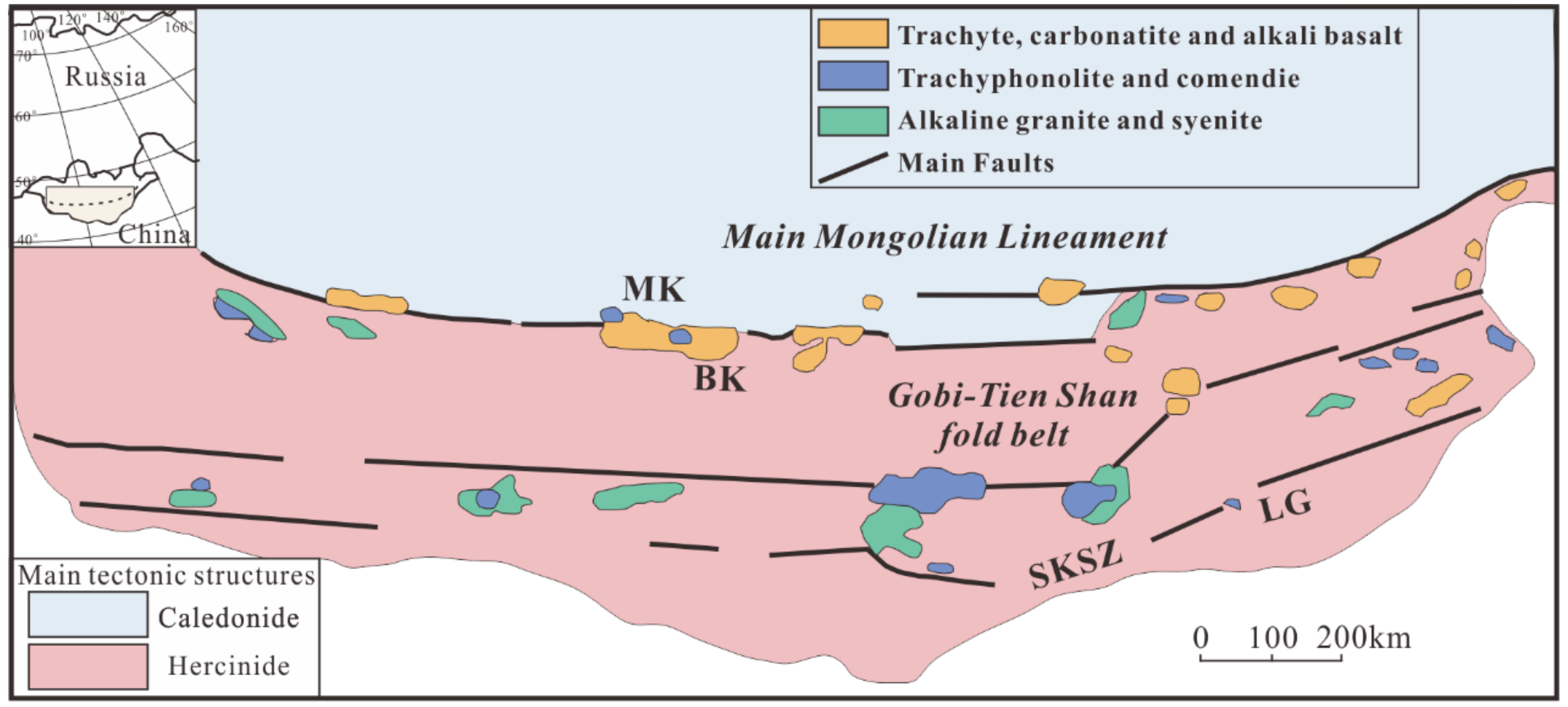
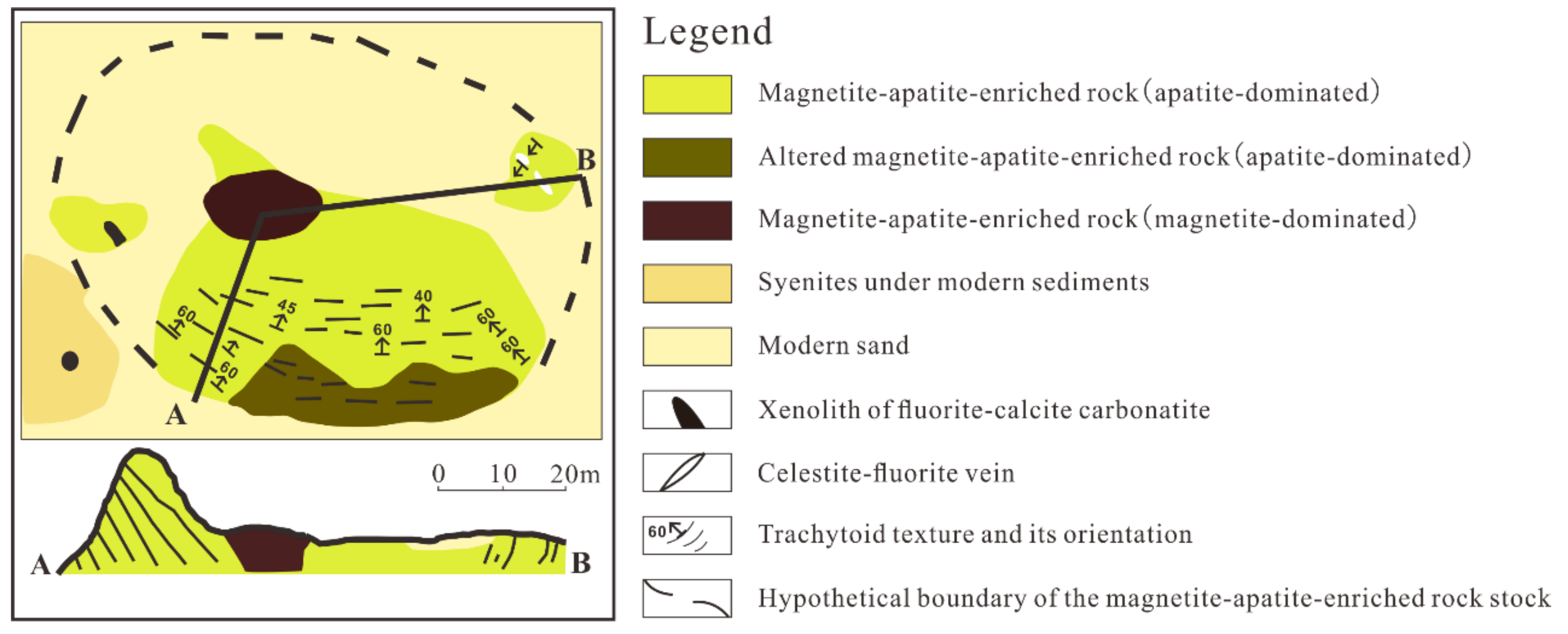
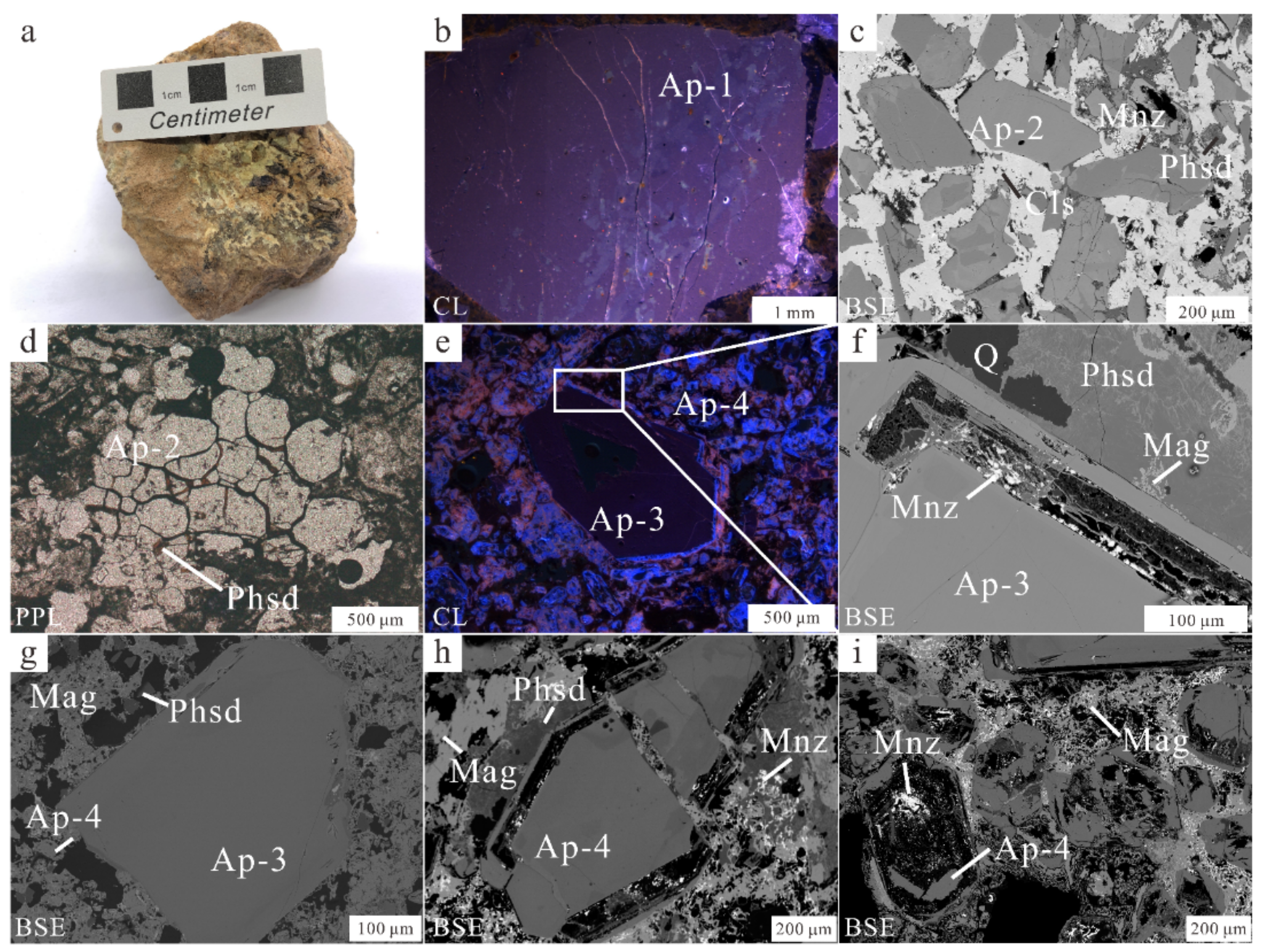
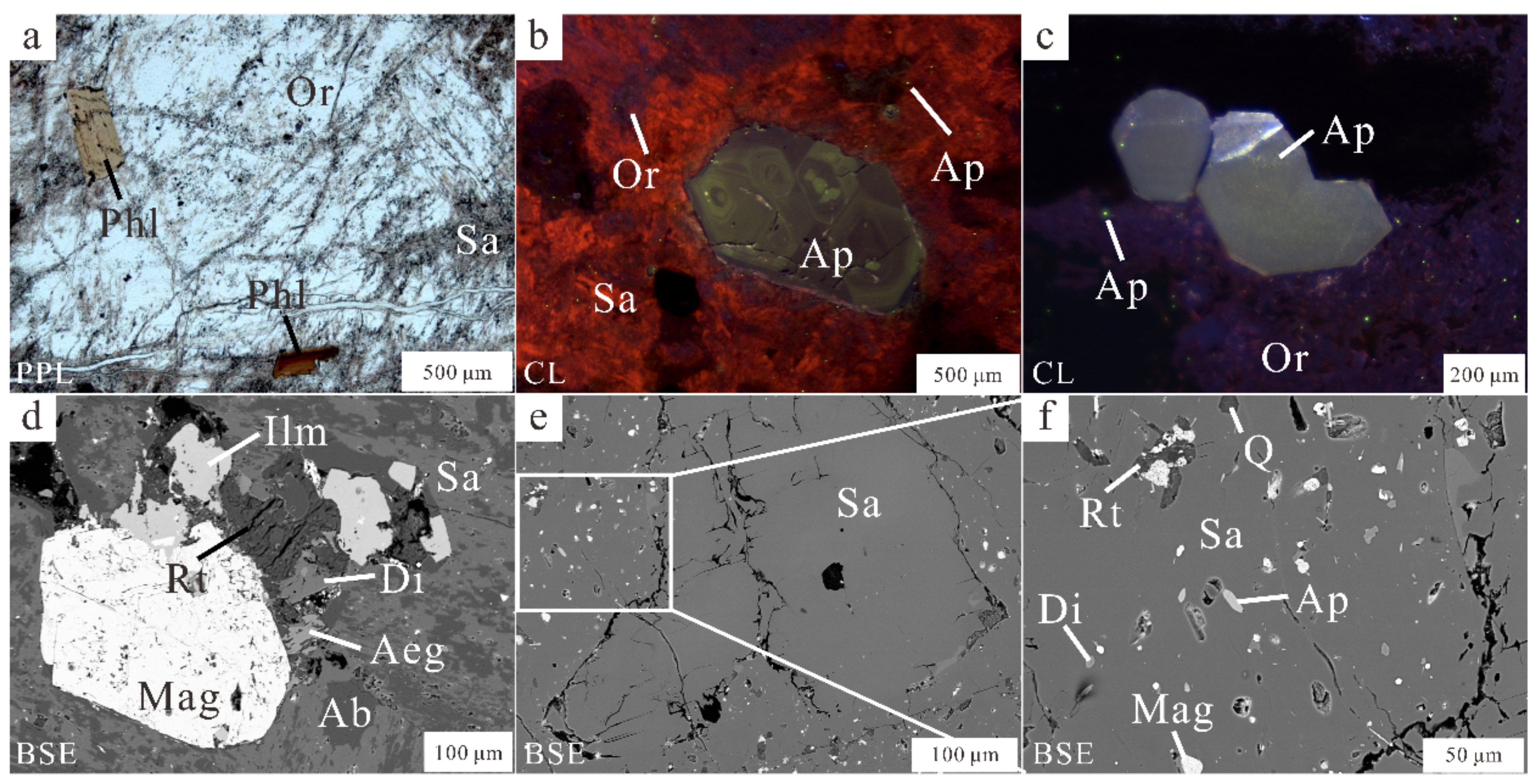
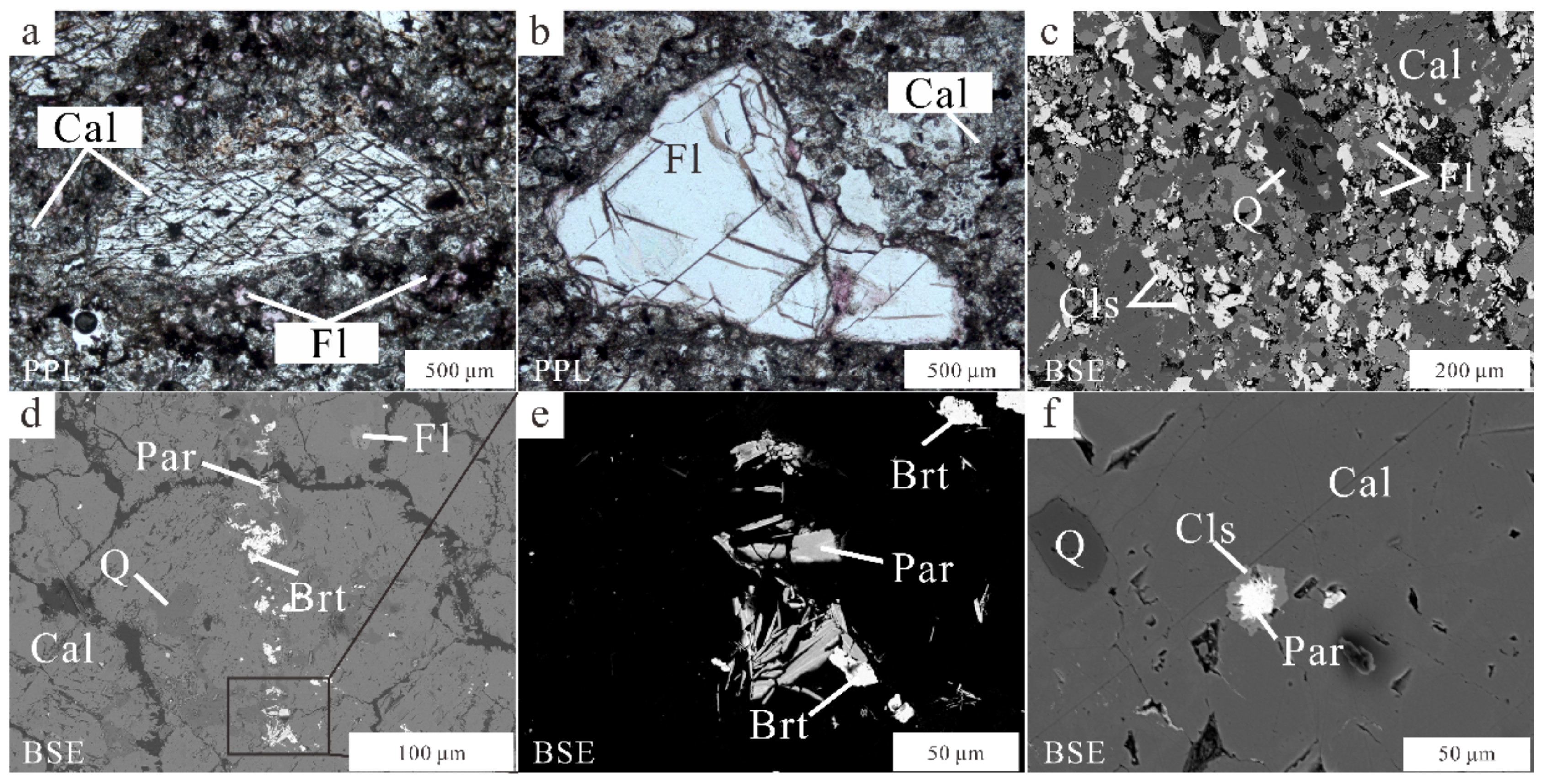
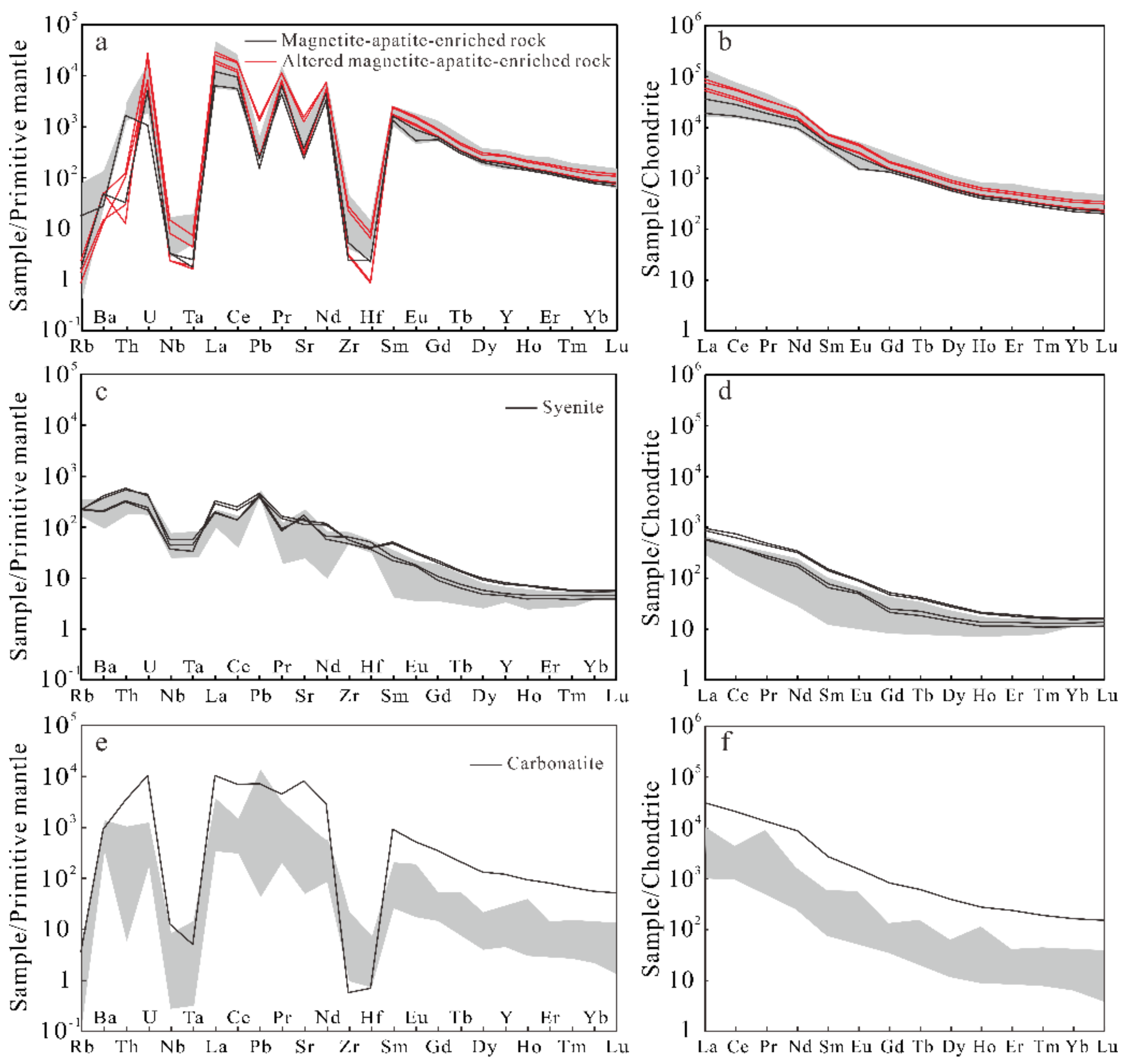
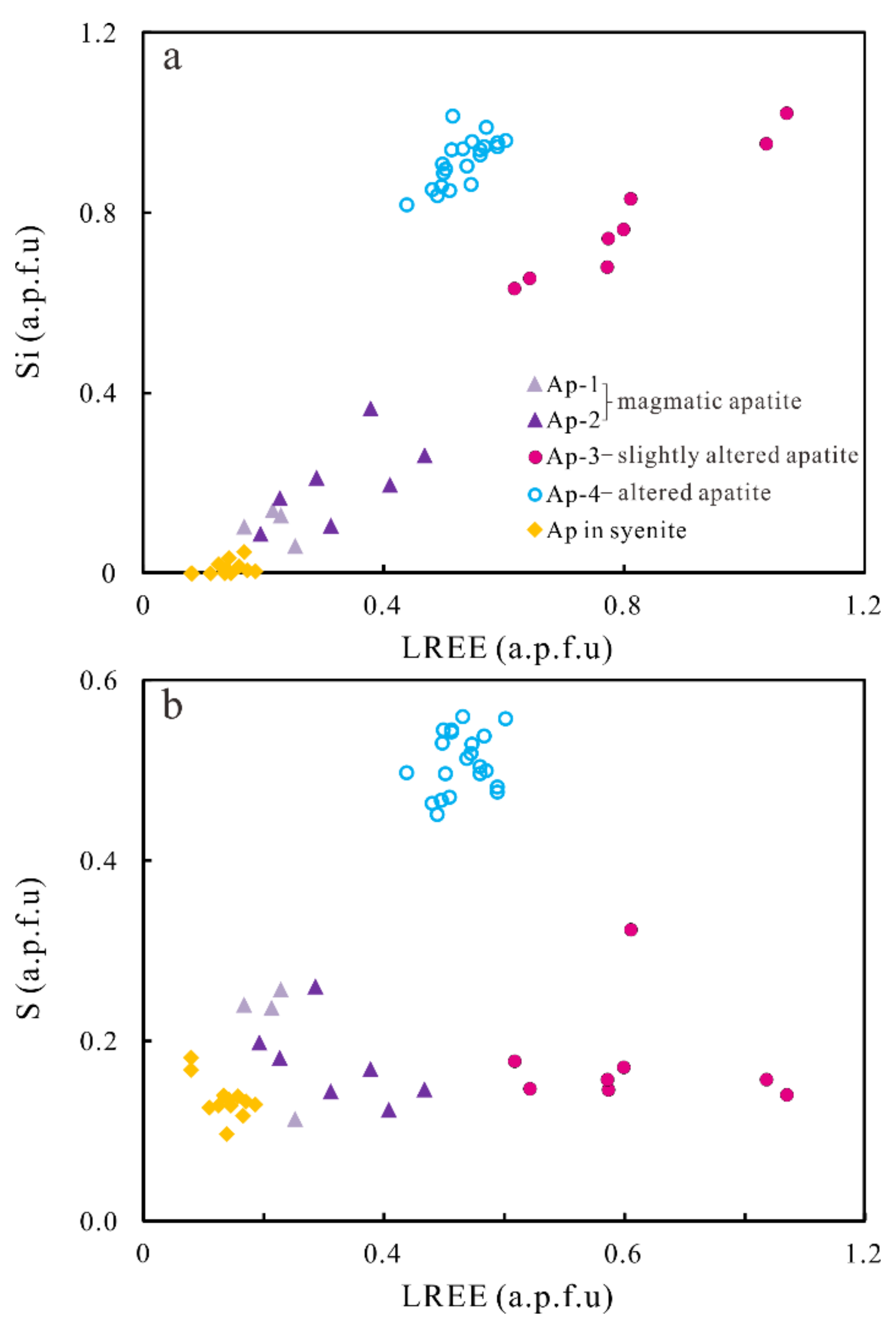
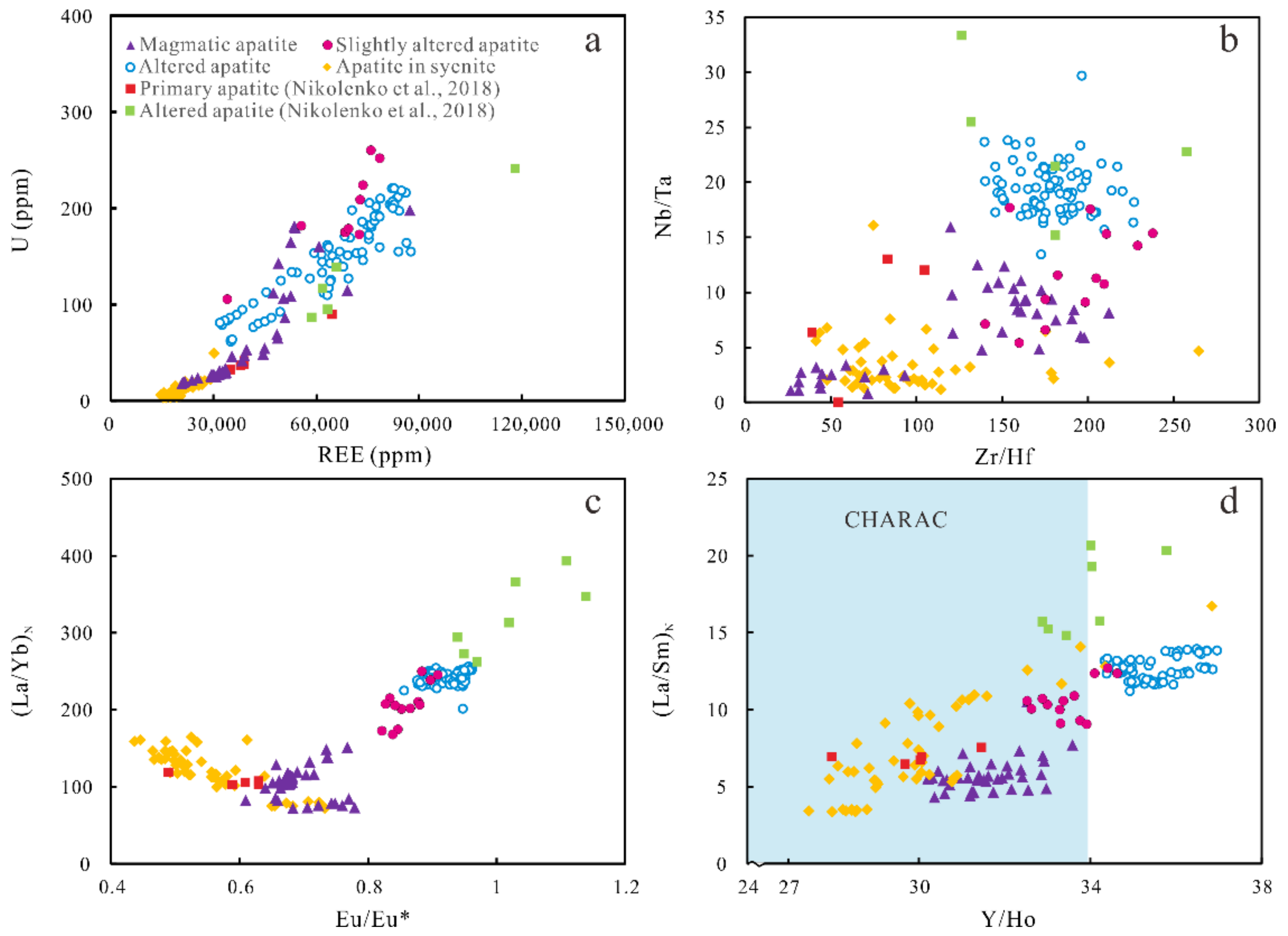
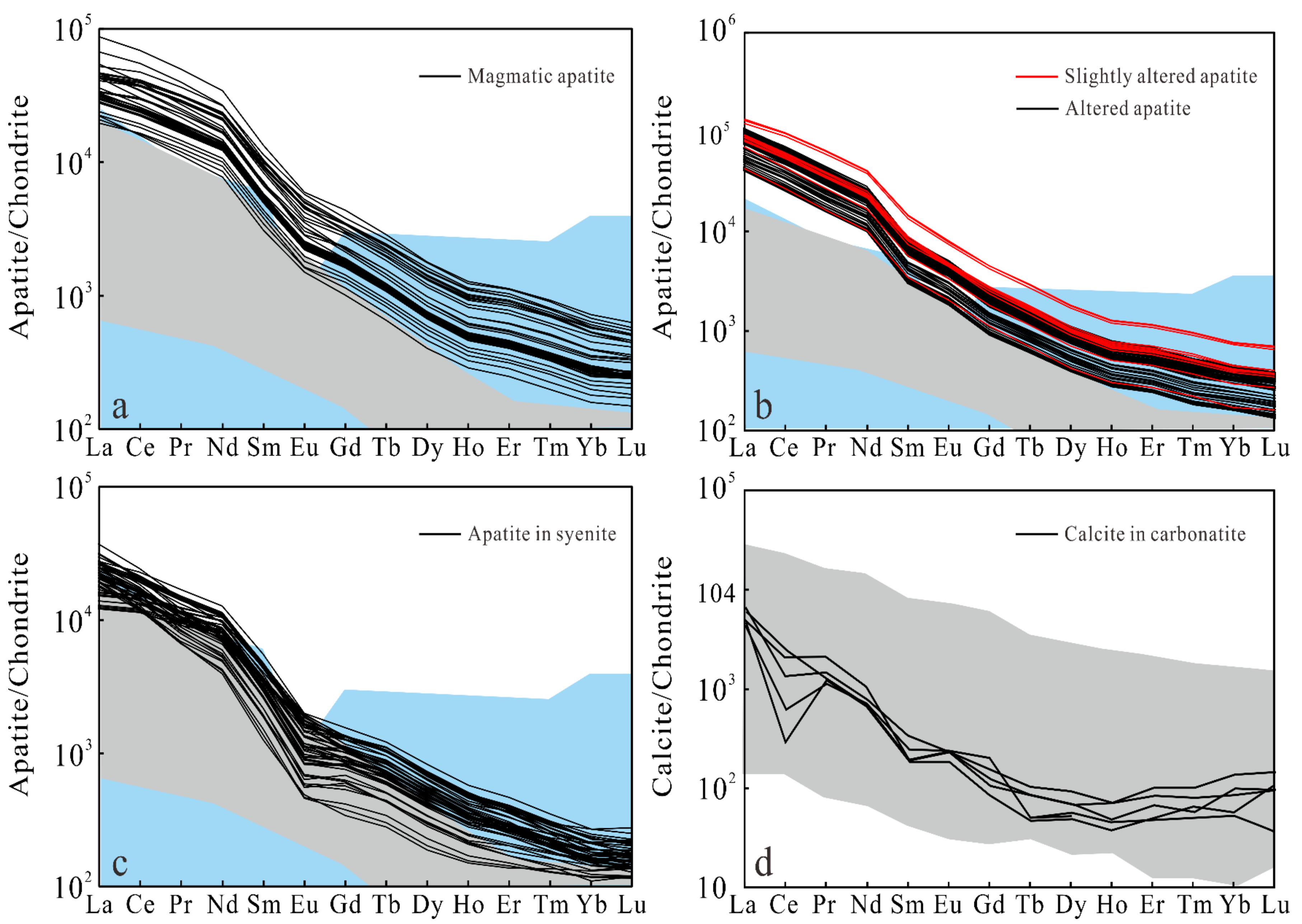
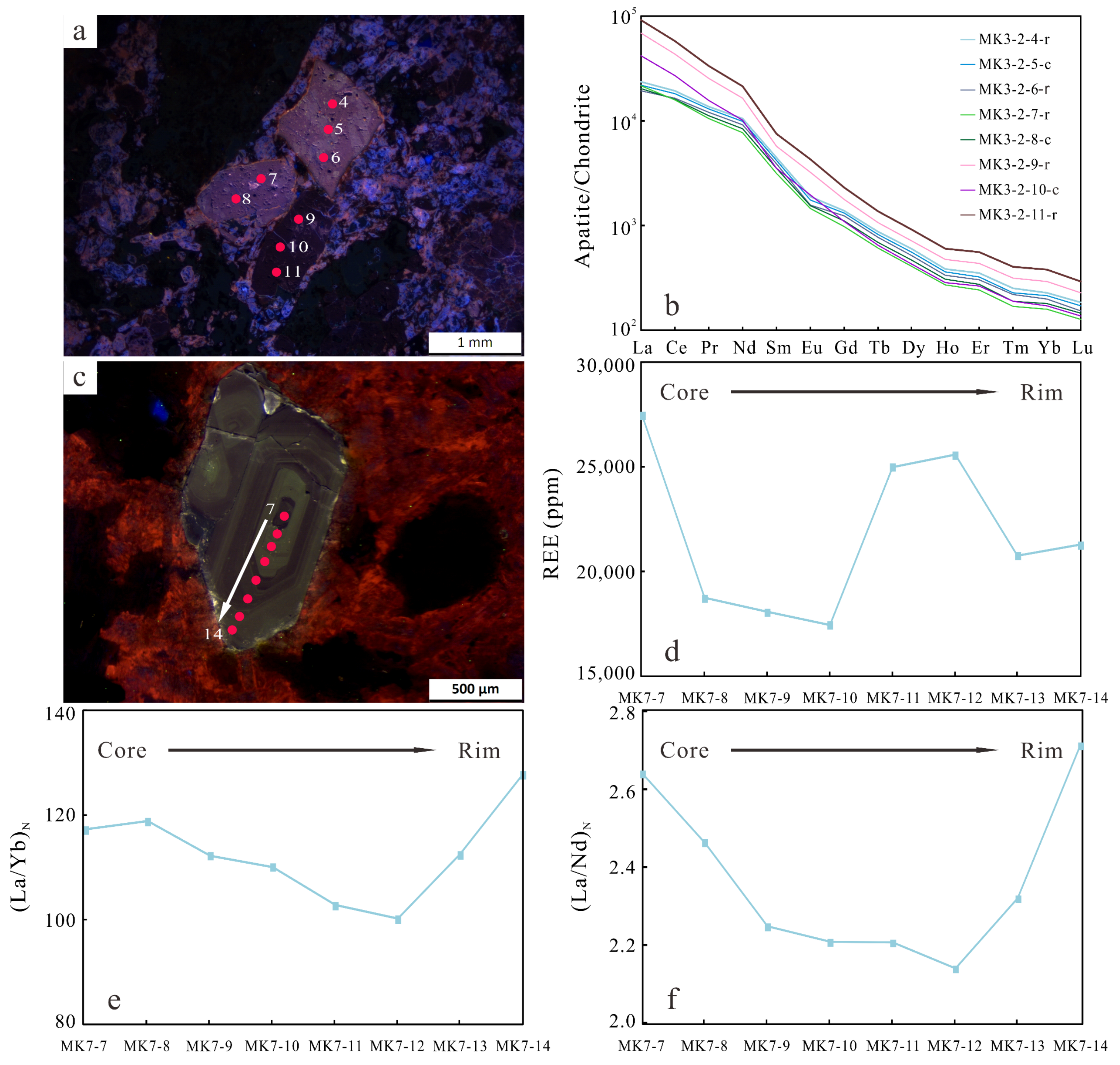
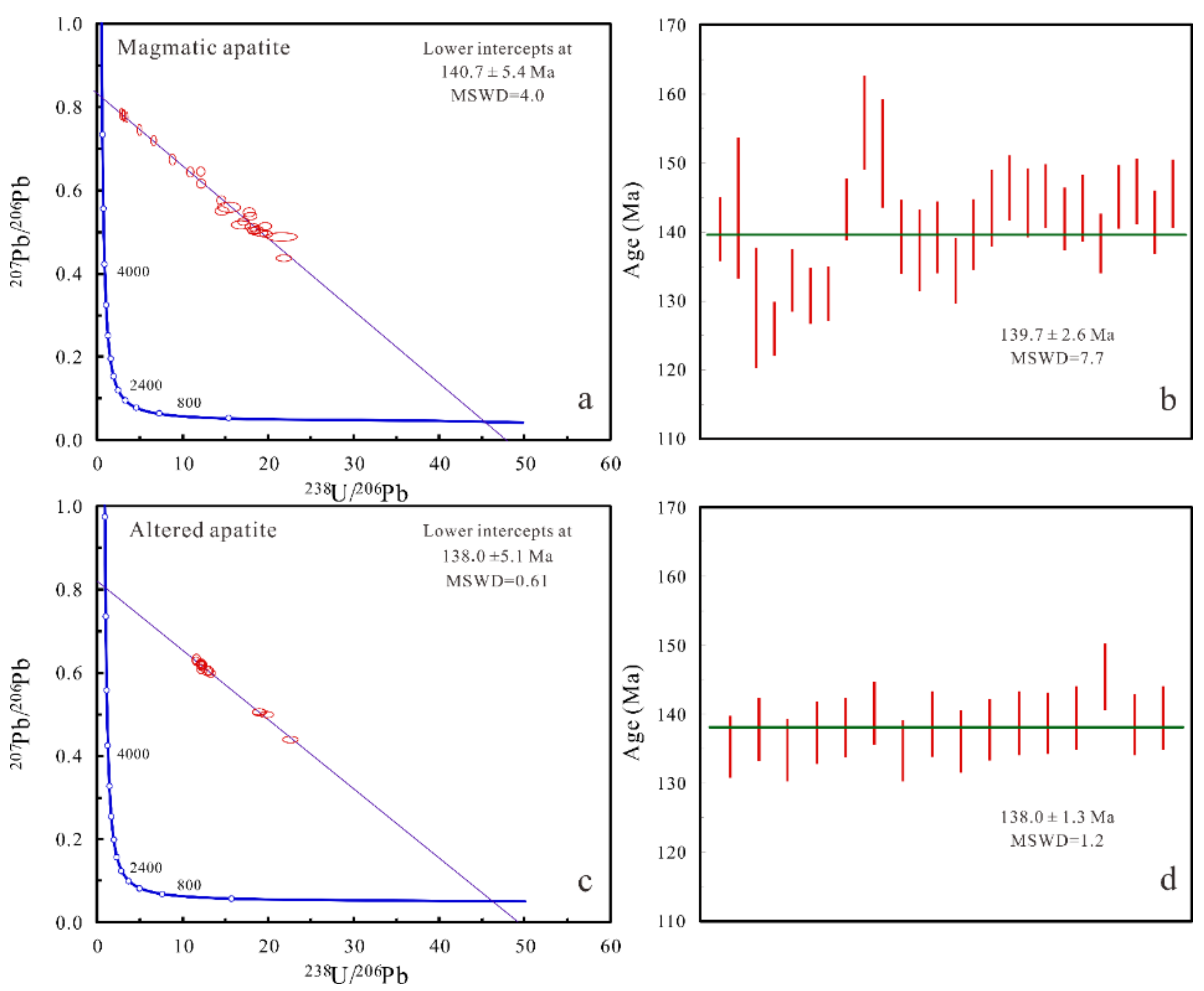
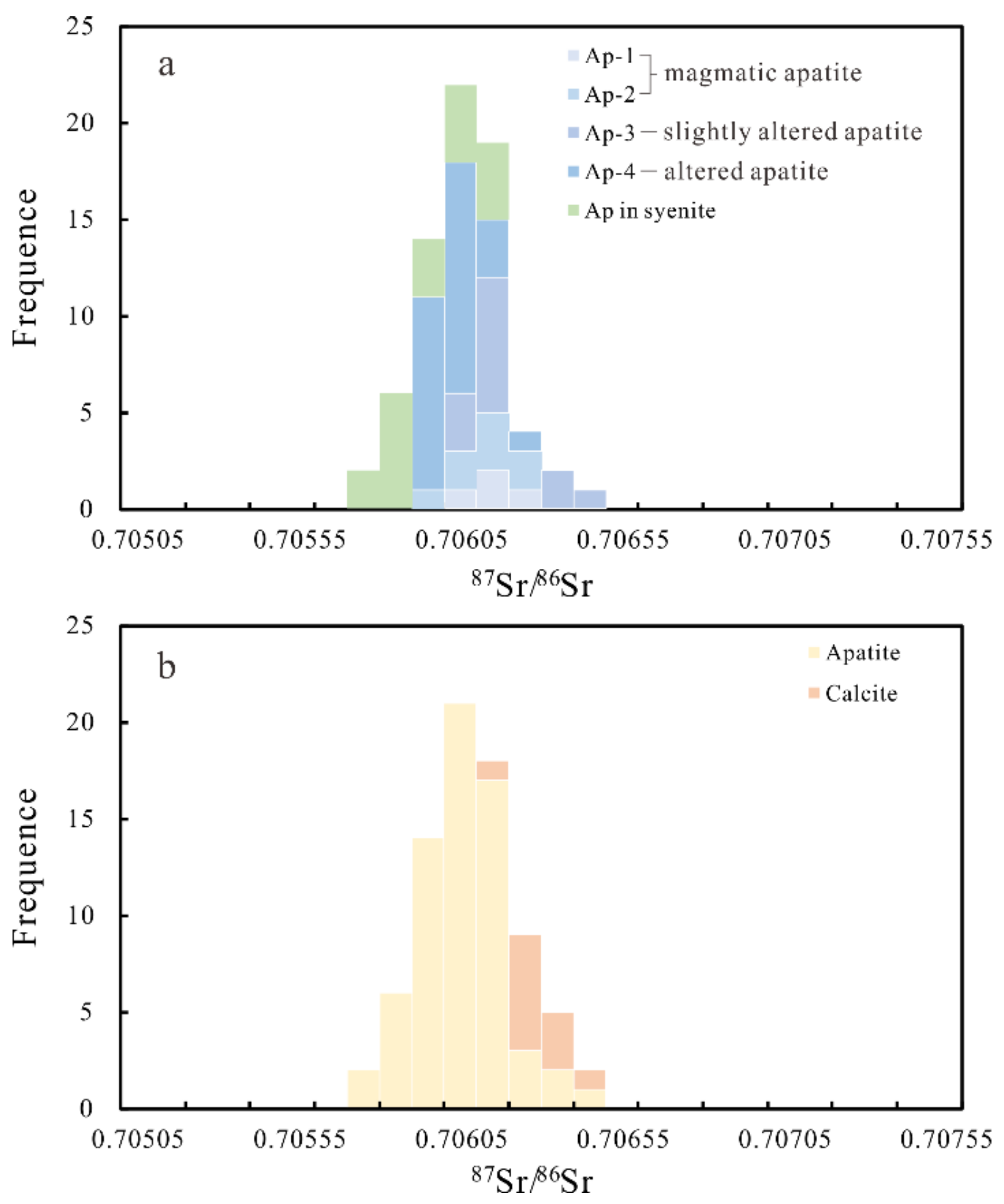
Publisher’s Note: MDPI stays neutral with regard to jurisdictional claims in published maps and institutional affiliations. |
© 2021 by the authors. Licensee MDPI, Basel, Switzerland. This article is an open access article distributed under the terms and conditions of the Creative Commons Attribution (CC BY) license (https://creativecommons.org/licenses/by/4.0/).
Share and Cite
Yang, F.; Chen, W.; Kynicky, J.; Ying, Y.; Bai, T. Combined In Situ Chemical and Sr Isotopic Compositions and U–Pb Ages of the Mushgai Khudag Alkaline Complex: Implications of Immiscibility, Fractionation, and Alteration. Minerals 2021, 11, 450. https://doi.org/10.3390/min11050450
Yang F, Chen W, Kynicky J, Ying Y, Bai T. Combined In Situ Chemical and Sr Isotopic Compositions and U–Pb Ages of the Mushgai Khudag Alkaline Complex: Implications of Immiscibility, Fractionation, and Alteration. Minerals. 2021; 11(5):450. https://doi.org/10.3390/min11050450
Chicago/Turabian StyleYang, Fan, Wei Chen, Jindrich Kynicky, Yuancan Ying, and Tian Bai. 2021. "Combined In Situ Chemical and Sr Isotopic Compositions and U–Pb Ages of the Mushgai Khudag Alkaline Complex: Implications of Immiscibility, Fractionation, and Alteration" Minerals 11, no. 5: 450. https://doi.org/10.3390/min11050450
APA StyleYang, F., Chen, W., Kynicky, J., Ying, Y., & Bai, T. (2021). Combined In Situ Chemical and Sr Isotopic Compositions and U–Pb Ages of the Mushgai Khudag Alkaline Complex: Implications of Immiscibility, Fractionation, and Alteration. Minerals, 11(5), 450. https://doi.org/10.3390/min11050450





